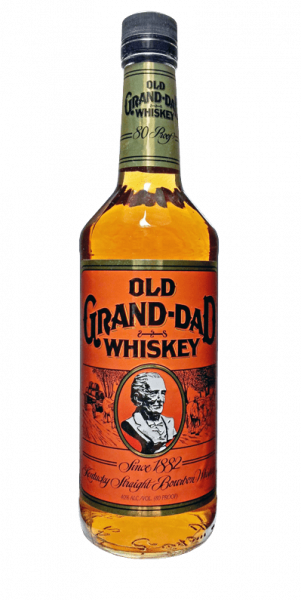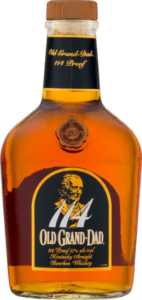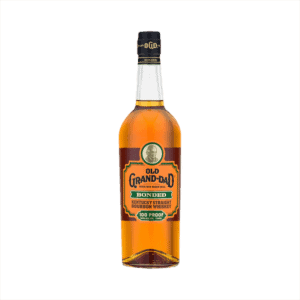This ‘bottom-shelf bourbon’ got it going on.
Bourbon lovers of all stripes — from the ultra-premium high-roller to the value-loving loyalist — have a great deal of respect for this old whiskey. It fits into any bourbon collection and doesn’t seem out of place with brands that sell for two or three times the price.
Pull up a chair, and we’ll tell you a story about one of the oldest and most prominent names in the long chronicles of bourbon history: Old Grand-Dad Bourbon.
History
The origin story of Old Grand-Dad bourbon began in 1796, when Meredith Basil Hayden, Sr., moved to Kentucky from Maryland.
Hayden began as one of the area’s many small-scale regional farmer-distillers. He made whiskey in the ‘new style’ that would become bourbon on the family’s land near Bardstown. By the time his grandson, Raymond B. Hayden, built a professional distillery in 1840 with business partner F. L. Ferriell, the family’s reputation for distilling a delicious high-rye bourbon was already well known throughout the Ohio Valley and beyond. Raymond named the new distillery — and the bourbon brand produced there — Old Grand-Dad after his grandfather Basil Hayden.
The timing of the new distillery turned out to be fortuitous for the business partners.
Despite Ferriell fighting for the Union during the Civil War, distillers throughout Kentucky benefited from the state remaining neutral during the conflict. As a result, Kentucky distillers could sell whiskey to both Union and Confederate states — when they were able to evade Union blockades. Business — and the reputation of Kentucky whiskey — boomed.
Raymond Hayden died in 1888 with no heirs. The business was sold to a prominent Kentucky horse breeder and furrier. Soon after, the brand began to go through the tumultuous Prohibition period of consolidation standard in the history of spirits brands from across the United States.
One interesting note from this period: For a few years during Prohibition, Old Grand-Dad was distilled and distributed as a Canadian whiskey.
Brands and maturation warehouses quickly consolidated through a combination of federal mandates, incentives and regulatory loopholes. At the time, the owners of the brand, the Wathen brothers, created the American Medicinal Spirits Company to purchase the many maturing barrels throughout Kentucky that had lost all value to the original distillers and sell them to customers as medicinal whiskey. They began distilling whiskey in the bourbon style north of the border to maintain supply.
AMS was absorbed in 1929 when National Distillers Products Corporation began actively acquiring brands towards the end of Prohibition. Jim Beam acquired National Distillers brands in 1987.
Today, Old Grand-Dad and the Basil Hayden’s brand with the same namesake are both produced by Beam Suntory. But as you’ll see in our subsequent sections, these two bourbons have special privileges compared to other legacy brands from the company.
Mashbill
Federal standards of identity require all bourbons to be made from a mash bill — or list of grain ingredients — containing at least 51 percent corn.
Old Grand-Dad has a mash bill of 63 percent corn, 27 percent rye and 10 percent malted barley. Old Grand-Dad shares this grain bill with stablemate Basil Hayden.
This is significant when considering these two brands are the only bourbons that diverge from the Jim Beam mash bill of 75 percent corn, 13 percent rye and 12 percent malted barley1.
Old Grand-Dad and Basil Hayden’s are considered high-rye bourbons, where Jim Beam is often thought of as a traditional bourbon. This is in line with the historical perception of Old Grand-Dad, which was often written about as having contained a higher percentage of rye grain than whiskeys made at surrounding distilleries.
High rye bourbons are known for having a spicier flavor, which often manifests as a spicy black pepper note out of the barrel.
Interestingly, other legacy brands produced by the same parent company have not maintained their original mash bill recipes. The Old Crow brand also joined the Beam Suntory portfolio. But it is produced today using the same mash bill as the Jim Beam brand, despite Old Crow newspapers advertisements from 19th century described it as ‘Rye.’
[SEE ALSO: Rye vs Bourbon]
Distillation & Production
Old Grand-Dad is produced at Beam Suntory facilities in Clermont and Boston, Kentucky. There, it is distilled using modern column-still distillation techniques.
Because it is made from an entirely different mash bill than other products from the two distilleries, one or both facilities likely switch over to production runs of the ‘Old Grand-Dad’ recipe for several weeks or months of each distilling season based on the company’s production and sales goals. While this is certainly not required by law, it would help the company capitalize on efficiencies within the system.
For example, the Jim beam Distillery has a 10,000-gallon cooker — or mash tun — and nearly 20 large-scale fermenters. The large column stills are fed through a continuous distillation system, where beer is fed to a beer still, collected and then fed into the spirit still or thumper. This type of system could ideally run indefinitely, although, in reality, it will shut down from time to time for maintenance and cleaning.
Imagine an ecosystem where the cooker is continually grinding in new grain, heating it according to recipe specs before it cools, yeast is pitched and the liquid transferred to fermenters for about five days. Then, terminal beer is alternately pumped into the beer still, then the spirit still and clear new make or white dog bourbon is collected out of the spout.
One notable product attribute of the 114-proof version is that it comes off the still at a lower 127-proof — as opposed to the standard ~150-proof — which means it most likely includes way more congeners and fatty oils, which pick up bold and distinct flavors from the barrel during the maturation phase.
If you were to alternate between Jim Beam’s 75 percent corn recipe and Old Grand-Dad’s 63 percent corn recipe, it would throw a monkey wrench in the works. Rather than lining those fermenters up like dominoes before knocking them down, the whole system would need to be cleaned and then swapped — or, the spirit coming out the end would pick up the alternating flavors of indefinite mash recipes throughout the intermediary runs — precisely the opposite of what a finely-tuned production team like that run by Beam Suntory would wish to accomplish.
Contrast this scenario with shutting down production for an evening to swap out between Jim Beam and Old Grand-Dad runs. Cookers, fermenters, stills and lines can all run clean, and the production team can look for the subtle flavor characteristics distinct to each brand as the spirit comes off the still.
That seems to make more sense.
Beam Suntory maintains a bottling facility at the old National Distilling site at the Fork of Elkorn outside of Frankfort, Kentucky.
While researching this post, we noticed some whiskey retailers listed Old Grand-Dad as being produced in Indiana. We’re not sure what that’s about, other than Old Grand-Dad was at one point distilled by National Distilling Products — also known as NDP, three letters that are also synonymous with the term Non-Distiller Producers in the United States. Because Old Grand-Dad has a different mash bill than Jim Beam, and the majority of Non-Distiller Producer brands come from MPG based in Lawrenceburg, Indiana, it could be that these retailers mixed them up. Or, they might know something we don’t know. Or, we’re totally off our rocker. But either way, we should note that all of our research points to the bulk of production taking place at the Clermont facility and we have not discussed this post with any of the Beam Suntory production team to verify our understanding of the production techniques.
Maturation
After distillation, the whiskey maker is left with a clear, unaged white dog or newmake spirit. Next, they will rack the whiskey into barrels for it to mature. During the maturation process, whiskey takes on its distinct red-brown color and picks up much of its bourbon flavor from the barrel.
By law, all bourbon must be matured in new American charred oak barrels. All the barrels used by Beam Suntory whiskeys have a level 4 or ‘alligator’ char — which describes a barrel whose insides have been exposed to flame for a longer duration. With more prolonged exposure to flame, the barrel picks up a deeper layer of char, which is responsible for giving much of bourbon’s distinct bold flavor as well as much of its smokey character. The char layer also acts as a crude carbon filter, removing undesirable flavor compounds and congeners that have made it through the distillation process as the spirit inside moves in and out of the red layer beneath — where it picks up much of its color and the oak flavors of baking spice, cinnamon and vanilla.
As the barrel matures, the spirit moves outward into the wood as the liquid expands in the hot months of summer, then back into the center of the barrel as it constricts during the cold temperatures of winter. This constant movement of the spirit — helped along by Kentucky’s distinctly cold, snowy winters and hot, humid summers — is made more pronounced by the large, non-climate controlled, multi-story wooden maturation rick or rackhouses common in the Bluegrass State.
As a ‘Kentucky Straight Bourbon Whiskey’ product that does not carry an age statement, we know that Old Grand-Dad was aged for the requisite two years in new charred American oak barrels and can assume that the liquid is likely at least four years.
Ownership, Brand-Extensions, Price Point & Value
Old Grand-Dad is owned and produced by Beam Suntory, the third-largest spirits company in the world. In addition to the standard Old Grand-Dad offering, additional products are widely available for bourbon enthusiasts to enjoy.
The original Old Grand-Dad orange label bottle will cost you only about $17 for a 750mL bottle at 80-proof, or 40 percent alcohol by volume. This suggested retail price puts this bottle at the low end of the standard segment – and shows why this brand is renowned by both the whiskey connoisseur and average bourbon drinker as a bottom-shelf bourbon that bats way out of its league.
Old Grand-Dad Bottled in Bond is a product that is bottled at the requisite 100-proof and aged for the four years required by law in a government bonded warehouse. It must also be distilled during one distilling season – equal to one calendar year – by the same distiller. Old Grand-Dad Bonded will cost you about $25 for a 750mL bottle at 100-proof. Its price places it on the higher end of the standard range.
[RELATED: What does bottled in bond mean]
Old Grand-Dad 114-proof is a product that contains bourbon at 114-proof, which is closer to the alcohol level that the production team will dump from the barrel. As a result, the bottling offers a barrel-proof flavor profile at a very reasonable price point. You can expect to find Old Grand-Dad 114-proof or about $25, more-or-less line-priced with Bonded, and also in the standard range.
[SEE ALSO: Cask strength whiskey]
Up for a challenge? Consider lining these three up for a blind bourbon tasting the next time you’re at your favorite whiskey bar to see if you can pick out the difference maturation and bottling proof make on the finished product.
1 Obviously, distilled products from other product categories – such as rye whiskeys – do not apply. Beam Suntory does not share mash bill information for Rye whiskey brands like Old Overholt, or rye whiskey extensions of its major brands, including Jim Beam Rye, Knob Creek Rye and Booker’s Rye.
















